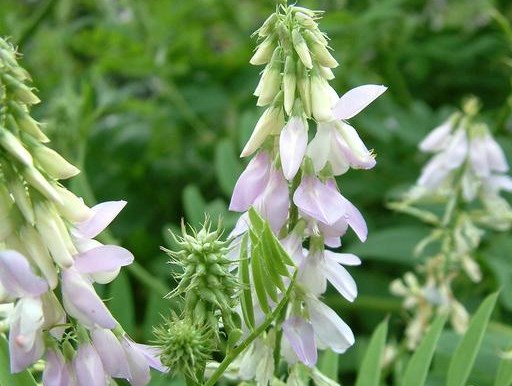Created by: Elizabeth D. Brusati
Created on: Tuesday, Jan 26th, 2016
Created on: Tuesday, Jan 26th, 2016
Yes or No:
Yes
Points:
1
Confidence Level:
High
Answer / Justification:
Two records in Calflora. Also in about 10 other US states and Ontario, Canada.
Reference(s):
Yes or No:
Yes
Points:
2
Confidence Level:
Very High
Answer / Justification:
Present in California, Utah, Colorado, Washington, which match California.
Reference(s):
Yes or No:
Yes
Points:
2
Confidence Level:
Very High
Answer / Justification:
On US Federal noxious weed list. Invades 60 square miles in one county in Utah. On Washington noxious weed list but the information is unclear about how widespread it is or if it's more of an alert species for prevention.
Reference(s):
Yes or No:
Yes
Points:
3
Confidence Level:
Very High
Answer / Justification:
Yes, invasive in Utah, which matches California.
Reference(s):
Yes or No:
No
Points:
0
Confidence Level:
Very High
Answer / Justification:
Galega orientalis listed by Randall 2012 as invasive based on reports from Estonia and the Upper Volga Basin, Russia, but these are not similar to California.
Reference(s):
Yes or No:
No
Points:
0
Confidence Level:
High
Answer / Justification:
Native to the Mediterranean, which is similar to California. Mostly in Europe, in areas not similar to California. GBIF map = http://www.gbif.org/species/2975667
Reference(s):
Yes or No:
Yes
Points:
1
Confidence Level:
Very High
Answer / Justification:
Galega officinalis forms dense thickets and competes with and reduces yields of forage plants. Can grow up to 2m (6 ft) tall.
Reference(s):
Yes or No:
No
Points:
0
Confidence Level:
Medium
Answer / Justification:
Did not find any mention of this.
Reference(s):
Yes or No:
Yes
Points:
1
Confidence Level:
High
Answer / Justification:
Goatsrue produces a toxic alkaloid, galegin, which lowers blood pressure and paralyzes the central nervous system (of livestock?). Toxic to cattle, horses, and sheep. Also reduces yield of forage plants. (However, also used to increase milk flow in cows.)
Reference(s):
Yes or No:
Yes
Points:
1
Confidence Level:
Medium
Answer / Justification:
Galega officinalis forms dense thickets and competes with and reduces yields of forage plants. Can grow up to 2m (6 ft) tall so it seems like these could be impenetrable.
Reference(s):
Yes or No:
No
Points:
0
Confidence Level:
High
Answer / Justification:
Reproduces by seed.
Reference(s):
Yes or No:
No
Points:
0
Confidence Level:
High
Answer / Justification:
Does not sound like it. Reproduces by seed.
Reference(s):
Yes or No:
Yes
Points:
1
Confidence Level:
Very High
Answer / Justification:
Reproduces by seed.
Reference(s):
Yes or No:
Yes
Points:
1
Confidence Level:
Very High
Answer / Justification:
Pods contain up to 9 mustard colored, oblong seeds. Each plant can produce 15,000 pods or more.
Reference(s):
Yes or No:
No
Points:
0
Confidence Level:
Very High
Answer / Justification:
Goatsrue seeds typically remain dormant until scarified and may remain viable for ten or more years. See the CDFA blog entry cited in Evaluation Notes. This is a new species added to the noxious weed list in 2015.
Reference(s):
Yes or No:
Points:
Confidence Level:
Answer / Justification:
Could not find information
Reference(s):
Yes or No:
No
Points:
0
Confidence Level:
High
Answer / Justification:
Flowers June and July.
Reference(s):
Yes or No:
Yes
Points:
1
Confidence Level:
Very High
Answer / Justification:
Seeds can be spread in animal manure.
Reference(s):
Yes or No:
Yes
Points:
1
Confidence Level:
Very High
Answer / Justification:
Seeds are spread primarily in irrigation water.
Reference(s):
Yes or No:
Yes
Points:
1
Confidence Level:
Very High
Answer / Justification:
Seeds can be spread by contaminated harvest equipment, soil equipment, animal manure, or alfalfa seed.
Reference(s):
Reviewed by Barbara Castro, CA Dept of Water Resources
Direct links to datasheets:
CABI - http://www.cabi.org/isc/datasheet/24756. Last modified 20 Jan 2015.
Washington - http://www.nwcb.wa.gov/detail.asp?weed=54
CDFA - http://blogs.cdfa.ca.gov/Section3162/?p=706
- < 13 : accept (low risk of invasiveness)
- 13 - 15 : evaluate further
- > 15 : reject (high risk of invasiveness)
PRE Score:
16
Number of questions answered:
19
Screener Confidence (%):
89.5
Organization:
Evaluation visibility:
Public - accessible to all site users

